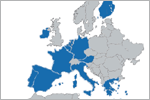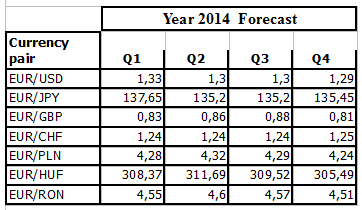Written by: Adam Narczewski, Financial analyst XTB Poland

The Eurozone is recovering. This statement can be heard among traders and investors in many countries. But is it really the case? The recovery in the Eurozone is very modest. Various economic indicators (including countries’ PMI reports) show the situation has improved since 2012. Nevertheless, one would be a crazy optimist stating the situation is under control. The European Central Bank (ECB) cut interest rates twice in 2013 – by 50bp in May and 25bp in November lowering the marginal lending facility to its historic low of 0,75%. Had these decision helped the economy? Looking just at the stats we can confirm. While experiencing negative growth for the whole 2012 and Q1 of 2013, Eurozone’s GDP increased by 0,3% in Q2 and by 0,1% in Q3. Progress is visible but the question is if in 2014 this tendency will be kept, or should we prepare for another downturn.
Currently, the ECB is forecasting GDP will decline by 0,4% this year but expects a 1,1% increase in 2014 and 1,5% in 2015. These numbers match the market consensus. There are risks for lower growth though that need to be taken into consideration. The prognosis is based on the assumptions that Asia (read: China) will keep growing at the current pace and that global trade will be increasing. Meanwhile, the instability of China's growth is a huge threat to the recovery in Europe. If Asia slows down, next year’s GDP for the Eurozone will certainly be below 1% for the whole year. As growth is affected mostly by Asia, European stock markets will be affected by the Fed cutting its quantitive easing program. I would like to see the U.S central bank acting now but it seems it will delay the process till next year. When the reduction of the buyback program will start we cannot expect such increases on stock indices as in 2013.
Low inflation is another problem of the public finance sector. Prices have been falling in the Eurozone for some time although we see a slight rebound since October (Pic.1). Still, such low inflation is expected to remain for some time and the ECB will have to deal with this problem. Lower inflation means that the income part of the budget in some Eurozone countries is already lower than in the previous year. This problem will build-up next year. It is a big risk, which the market is not noticing and discounting at this moment. I expect there will be pressure on the ECB to fight with too low inflation. That is why I believe the subject of negative deposit rates will return, and already in the first quarter, the ECB may lower its repo rate from 0.25% to 0.1%. The talks have been focused on the repo and deposit rates and it seems the main rate has been forgotten. I do not think Mari Draghi will want to lower it even further. If so, a 25bp cut in the first quarter of 2014 (the quicker the better, there is nothing to wait for) could happen lowering the marginal lending facility interest rate to 0.5%.
CPI inflation in the Eurozone. Source: Bloomberg
How in this situation Euro traders will find themselves? During 2013 the amplitude of the EUR/USD was 1000 pips (trading within 1.28 and 1.38) which was much less than in the previous years. In 2014 I expect this kind of volatility to stay, without any abrupt moves. The Euro should be under pressure due to the risks the Eurozone will be facing (low inflation, lower rates, risk of slower growth). Also, let’s keep in mind the Fed, which already started the reduction of the QE3 program and will continue to do so in 2014. This will certianly boost the USD. All this in mind, I expect a steady decline of the EUR/USD, all the way to 1.29 by the end of 2014. Similarly, the EUR should be depreciating against other major currencies. It should remain strong though against emerging market currencies, which will be under pressure (at least during the first half of 2014) when capital will start flowing out of the respective economies (due to the QE3 reduction). The forecasts for the Euro against major and emerging currencies I prepared in the table below (quotes expected by the end of each quarter of 2014):

Recommended Content
Editors’ Picks
USD/JPY holds near 155.50 after Tokyo CPI inflation eases more than expected

USD/JPY is trading tightly just below the 156.00 handle, hugging multi-year highs as the Yen continues to deflate. The pair is trading into 30-plus year highs, and bullish momentum is targeting all-time record bids beyond 160.00, a price level the pair hasn’t reached since 1990.
AUD/USD stands firm above 0.6500 with markets bracing for Aussie PPI, US inflation

The Aussie Dollar begins Friday’s Asian session on the right foot against the Greenback after posting gains of 0.33% on Thursday. The AUD/USD advance was sponsored by a United States report showing the economy is growing below estimates while inflation picked up.
Gold soars as US economic woes and inflation fears grip investors

Gold prices advanced modestly during Thursday’s North American session, gaining more than 0.5% following the release of crucial economic data from the United States. GDP figures for the first quarter of 2024 missed estimates, increasing speculation that the US Fed could lower borrowing costs.
Stripe looks to bring back crypto payments as stablecoin market cap hits all-time high

Stripe announced on Thursday that it would add support for USDC stablecoin, as the stablecoin market exploded in March, according to reports by Cryptocompare.
Bank of Japan expected to keep interest rates on hold after landmark hike

The Bank of Japan is set to leave its short-term rate target unchanged in the range between 0% and 0.1% on Friday, following the conclusion of its two-day monetary policy review meeting for April. The BoJ will announce its decision on Friday at around 3:00 GMT.